The Witness Review: A Witness to Disaster
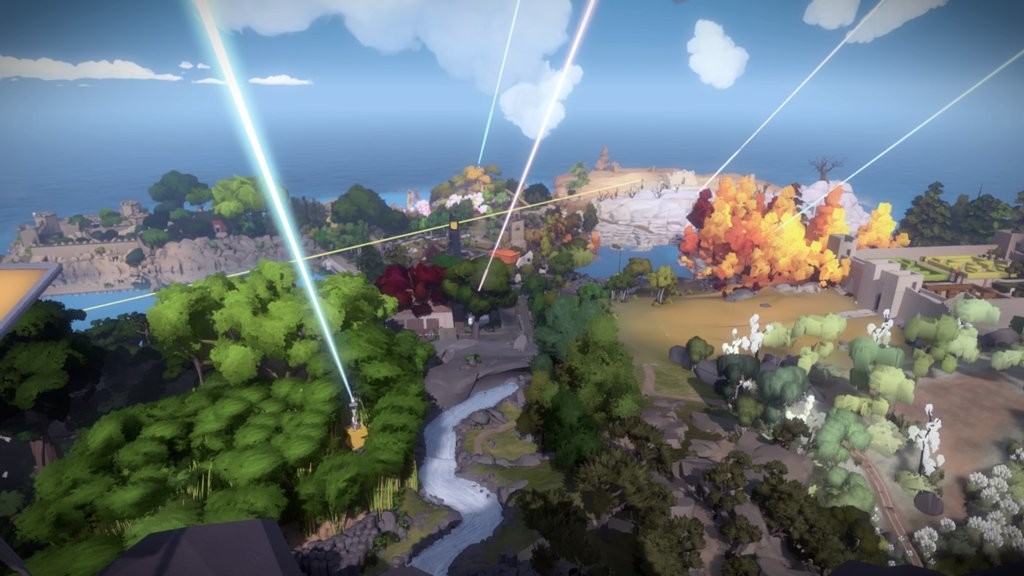
I feel that over the years I’ve gradually slid out of step with the mainstream when it comes to games. Whenever I glance over at “Best Of” lists at various gaming sites, I inevitably find a list of games that I either have no interest in playing or have played and didn’t like.
For example, I absolutely abhorred The Last Of Us. Bad controls, horrible story that’s been told a billion times over. Fallout? Hate it. Buggy mess. Ditto for The Elder Scrolls games (a Bethesda logo is a kiss of death to me). The original Dragon Age? Ugly, shitty characters, couldn’t make it for more than a few hours. The Batman Arkham games? Pretty vacant, with repetitive (and unresponsive) combat coupled with the pathetically heavy-handed writing. Dark Souls, Metal Gear (any of them), Undertale, The Witcher, The Walking Dead, I either hated them or couldn’t even be bothered to start them because they looked so boring, derivative or just not something I’d be into.
My point is that I am more than used to not being in jive with the critical consensus, and with rare exception I caulk it up to being an outlier. I hate a lot of popular games, but I realize that in many cases the issue is with me, not the game.
That being said, even I was surprised by the gulf between the critical consensus of and my personal views on The Witness, a game that many critics are lauding as one of the greatest of all time, and a game that I feel is a worthless exploration into just how little a game developer can care about his audience.

Hints of an amazing lost world fill the otherwise sterile environments.
For those who may not know, The Witness is a first-person adventure game where you play as an unnamed protagonist on a mysterious island who tasked to solve puzzles for some reason or another. No explanation is given for any of this. You just wake up in a tunnel and start solving puzzles to make your way through the various environments of the island, which range from mysterious desert ruins, abandoned buildings and giant castles.
Gameplay consists entirely of traversing the island and solving said puzzles, which more often than not take the form of small mazes on panels you interact with. The mazes start out simple, but quickly snowball in complexity. Some may have you separate certain shapes while following a certain rule set. Others may ask you to form certain shapes with the path you create. Many times you’re asked to do both, while sometimes incorporating hints you find in the surroundings to help you solve the puzzle and move onto the next. Solve enough puzzles in any given region, and a massive laser cannon shoots up a sculpture found atop a mountain. Do that several times and…more things happen.
At the start, things are great. The Witness is an absolutely stunning looking game, and the world it places you in is wonderfully tantalizing, with gorgeous yet barren environments hinting at a grander story buried under the island’s quiet facade. And the puzzles are fun at first too. They escalate slowly, holding your hand through the first few rule sets before casting all tutorializing aside to let you explore (nearly) all of the island from the get go. Letting you find your way on your own.
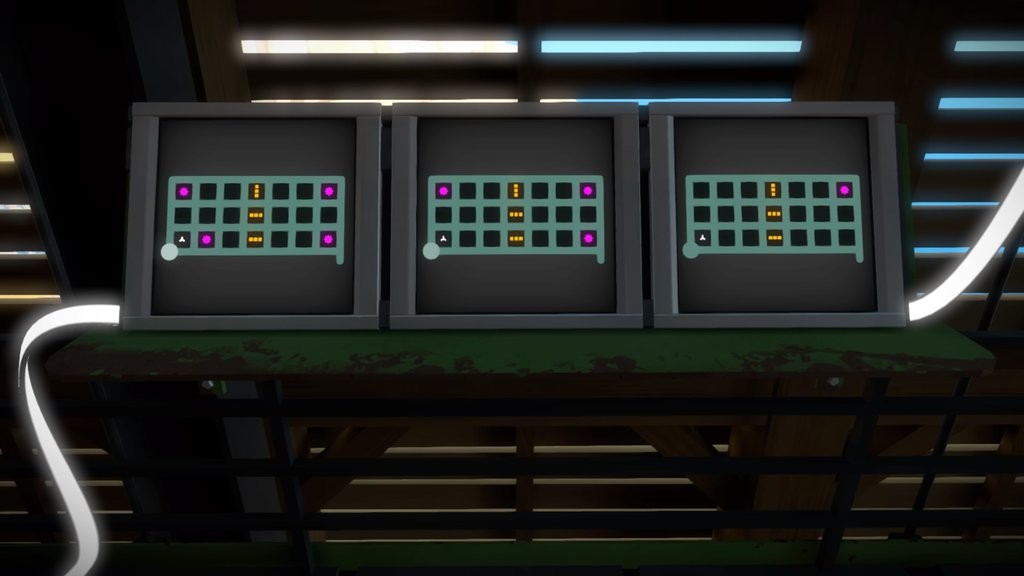
An early puzzle that breaks your brain, but has a clear rule set.
This open-endedness is where the game begins to fall apart. While you can go damn near anywhere to start, you damn well shouldn’t. Some areas’ puzzles are built on rules established in other areas, so traveling to them out of order will present you with seemingly hopelessly complex mazes beyond your current comprehension of the game’s mechanics. When this first happens, you quickly figure it out and abandon a confusing section for returning to later. But as you traverse more of the island, the line between puzzles that you can’t possibly solve because the rules haven’t been explained to you, and puzzles that are possible to solve but just really hard, begins to blur.
Eventually for me, that line vanished, and that’s when the game went from challenging, to frustrating and borderline unfair at times. It also likes to be intentionally deceptive when it sets up a section’s rules via tutorial puzzles. While it’s obviously teaching you one thing, it’s actually covertly subverting that lesson, subtly pointing out the “real” set of rules that you’ll need to conquer the section. Sometimes this feels neat, other times it just feels like a cop out. It’s one thing to craft a rule set and then devise a series of increasingly difficult puzzles based around it. That’s fun. It’s another to secretly subvert your rule set without stating it. That’s not clever, that’s just poor instruction. Knowing what to do but not knowing how to do it is a fun puzzle to deconstruct. Not knowing what to do, not knowing how to find out, and not knowing if you know what to do when you think you have found it out, that’s just aggravating. Then there are the puzzles where the mechanic is painfully obvious, but the solution is in the environment and the game becomes a 21st century pixel hunt, as you wander aimlessly trying to find just the right angle that will give you the solution. There’s zero deduction here, no puzzle solving skills at play, just searching for the right angle.
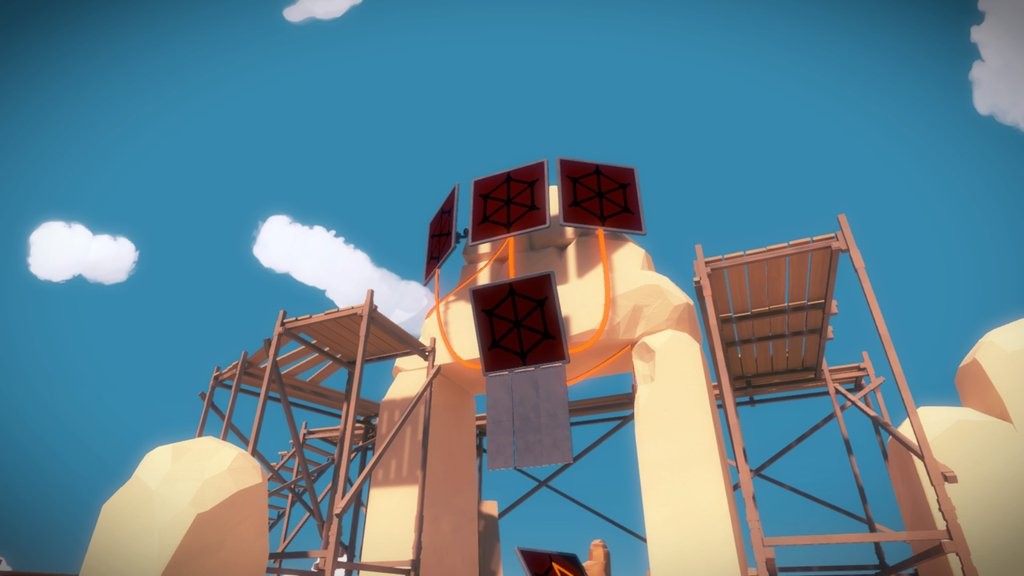
Some puzzles boil down to navigating a world just to find the perfect angle, and don’t require much puzzle-solving skills.
When I was a kid, I was fanatically obsessed with games by Sierra On-Line. They more-or-less invented the graphical adventure game in the early 80s, and went on to make some of the most popular PC games of the 80s and 90s, with classics like the Space Quest and King’s Quest series among them. While I loved the games as a kid, going back to play them now has proven to be difficult.
The problem with Sierra games is that most of them are brutally unfair, relying heavily on trial and error to find the right path or solution to a problem. Furthermore, many of them can leave you trapped if you failed to click on or pick up an object several hours beforehand, forcing you to play the game over from the beginning. While this was somewhat forgivable at the time (games were new after all, and the rules were still being written), now people look back at Sierra games for what they were; equal parts groundbreaking and frustrating, clever yet brutally unfair.
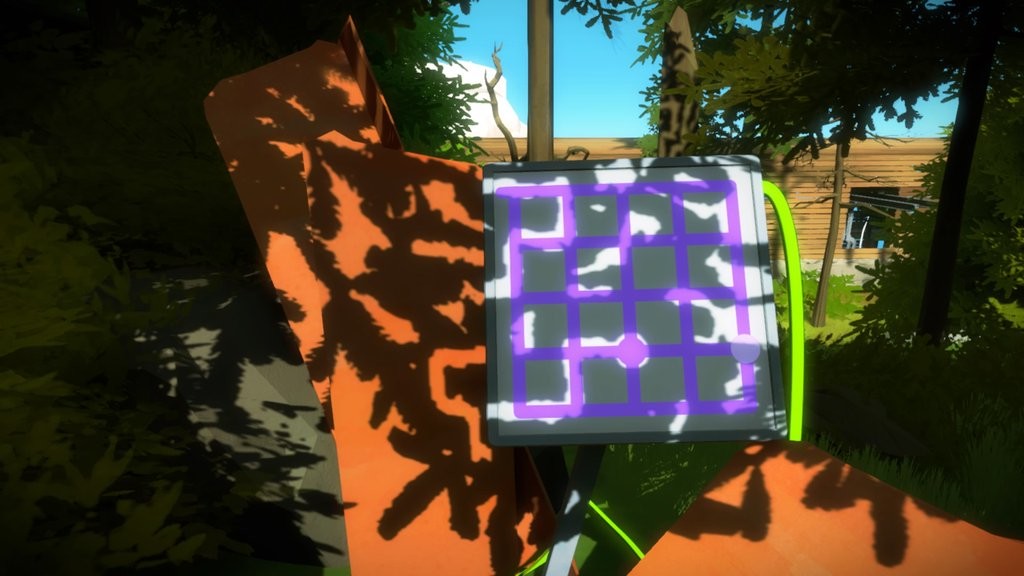
I still can’t figure this out.
Strangely, I feel that in some ways The Witness is a throwback to the Sierra way. Sure, there’s no unfair endgame state nor are your under constant threat of sudden annihilation simply for clicking on the wrong pixel, but the game installs in the player the same sense of confusion and befuddlement that the earliest Sierra games were known to do. And while The Witness might not leave you stranded in an area because you forgot to pick up a special item five hours back, it might leave you stranded because it reinstates a game mechanic from a previous section that you haven’t played in several hours (or days if you have a life) and have now forgotten completely. This isn’t an endgame scenario, but it is a situation where you might have to trek across the island (possibly getting lost along the way) to find a reminder of the mechanic in question, which leads me to my other big problem with the game, which is that The Witness isn’t really concerned with helping the player in even the most rudimentary fashion.
The world of The Witness is pretty big and the landmass itself can be confusing at times. But does it provide a map? Nope. How about some sort of fast travel system? Not really, the vehicle they provide you with makes travelling from point to point a little easier, but not much faster. How about any kind of pointer letting you know what puzzles you haven’t solved? Nope, not here. The game doesn’t even tell you which puzzles you need to solve to access the game’s initial endgame scenario, and which are actually for another set of challenges entirely, unrelated to completing the game. I spent probably one hour banging my head on a puzzle only to realize that it had nothing to do with the task at hand and was entirely optional. I found this out by checking a spoiler-free forum online. How I was supposed to know this without someone telling me is beyond me.
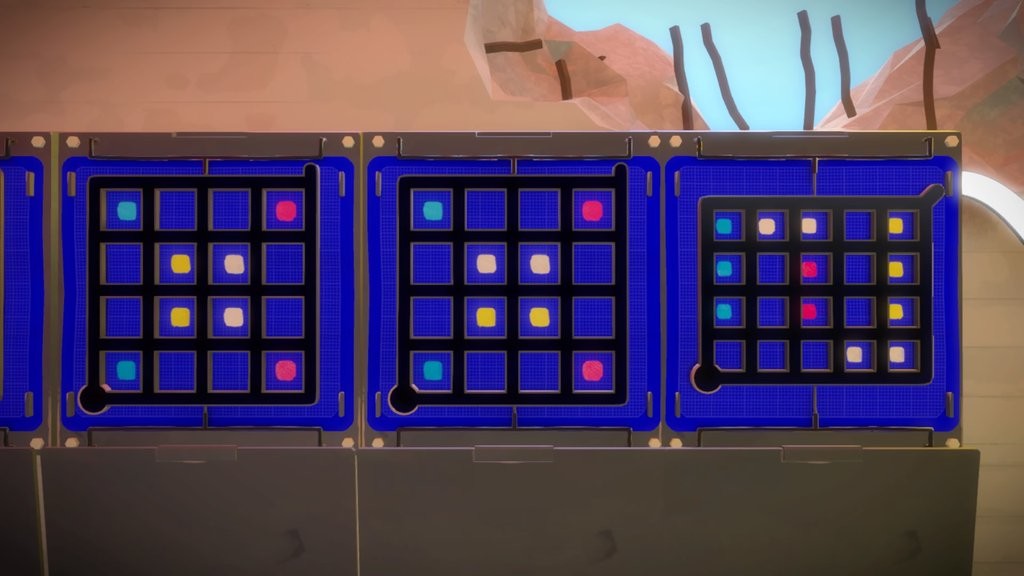
The game starts to be intentionally vague with its rules and that’s when it started to lose me.
I suppose that including any sort of guide points, in world map or assistance would break the aesthetic of The Witness, which is purposely sterile. But I feel that a game’s devotion to a style shouldn’t come at the cost of gameplay. Perhaps I might feel differently if…
Okay, I really can’t get into this next problem without diving headfirst into spoiler territory. So here’s your warning:
GIANT SPOILER WARNING. I AM ABOUT TO SPOIL THE END OF THE WITNESS. SERIOUSLY. I’M GOING TO SPOIL IT ALL. IF YOU AT ALL CARE ABOUT COMPLETING THIS GAME AND BEING SURPRISED AT WHAT AWAITS YOU AT THE END, STOP NOW.
YOU’VE BEEN WARNED.
I MEAN IT.
Okay. So the world of The Witness is a fascinating one. A city left unfinished sits in the middle of it. Ruins scatter across and underneath a desert. Quarries and machinery dot the rich and luscious forests. Enclosed inside a windmill is a theater where you can unlock various clips that discuss science and art. And spread about the entire island are beautiful statues, supposedly of its inhabitants. When you climb the mountain that starts the endgame, you’re treated to a series of statues that seem to allude to how it all went wrong, and how society on this seemingly idyllic island collapsed. So The Witness does a really great job of world building, creating a place that hints at a bigger story, one that is seemingly set to be explained upon the game’s conclusion.
But that’s not the case. If you beat the game with the bare minimum of puzzles completed, this is what you get. (Skip to 7:30 to get to the actual ending…finding a video of just this ending without commentary, glitches or other bullshit was difficult.)
Yup. That’s it. No explanation, just some vague (surprise more vagary) non-sequiturs as you drift off back to where you came.
Endings in games are a tricky lot, and I understand that. And a bad ending does not always make for a bad game. But the ending to The Witness is doubly disappointing. Not only is it a let down narratively, the setup for the game is so grand and seems so ripe for a pay off that doesn’t come, but it’s also a travesty in relation to just how damn hard the game is. When presented with a series of challenges as endlessly frustrating as The Witness, one expects something big in return. To rack your brain against the game non-stop for what could be dozens of hours only to be given a non-ending that resolves nothing and rewards you with nothing just seems like a slap in the face.
But there are two endings to the game, if you can complete every puzzle on the island and find a secret area, an optional end challenge is unlocked. From what I’ve seen and read, this challenge is insanely difficult and timed. It’s a real mother, and most people who attempt it probably won’t be able to complete it. For those who can, this is what awaits them.
What. The. Fuck.
So, what are we to take from that piece of cinematic? It would appear that The Witness is all a dream by a seriously ill man. A seriously ill man whose been placed under intense medical care inside…the house of a game developer?
“It was all a dream” endings have been the butt of jokes for decades, even long before Dallas gave the world the end-all be-all example of how disastrous they could be in the mid-80s. They’re the refuse of the lazy and uninspired, a cop out for those who can craft a story but can’t be bothered to finish it. They rarely work because they suggest the entire story that came before it just didn’t matter. They’re transparent examples of when a storyteller just gives up.
In the case of The Witness, this ending is even more insulting because the developers couldn’t even be bothered to film said ending in a real location. Instead, they just used the home of lead developer Jonathan Blow. And they didn’t even bother to try and hide the shadow of the camera rig on his head. Imagine if at the end Taxi Driver, the movie faded to black and then it cut to Scorcese in his house looking in a mirror and saying, “wow, that was a fucked up dream that I, the director of the movie you just watched, had. Anyways, life is pain and we’ll all die. So think about that!” all while the boom mic was in view. That’s about how much effort Blow put into the conclusion of this game. He couldn’t even be bothered to put forth effort into the fact that he couldn’t be bothered. The game and this ending have zero in common. If they do then that connecting arch is the biggest puzzle of all.
The Witness is self-involved navel gazing, the gaming equivalent of a bad art house film. It loves the world it created, and wants you to love it to, despite not given a reason to. It wants you to scour the darkest recesses of your brain to solve some of the hardest puzzles imaginable, but doesn’t reward you when you do so. And it wants to present some sort of message about technology, science and faith, but can’t be bothered to do so via a narrative, instead relying on optional audio logs that in truth have nothing to do with anything.
It wants to be smart. More precisely, it wants to make you feel smart for engaging with it. But at the end of the day, the most enlightening moment I had when playing The Witness was when I decided to quit it and never return.
Leave a Reply